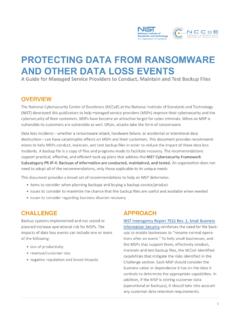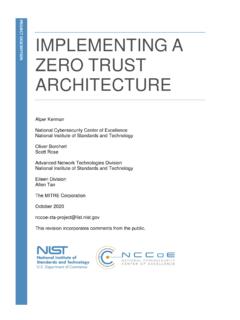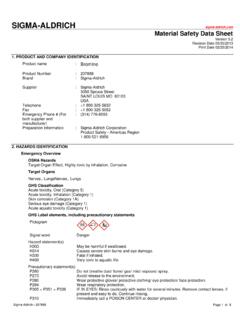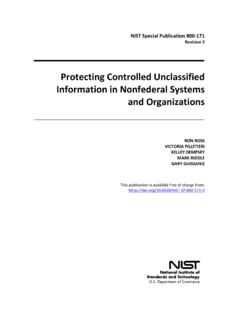Transcription of Data Classification and Practices - NIST
1 data Classification Practices Facilitating data -Centric Security Management Karen Scarfone Scarfone Cybersecurity Murugiah Souppaya National Institute of Standards and Technology DRAFT May 2021 PROJECT DESCRIPTION DRAFT The National Cybersecurity Center of Excellence (NCCoE), a part of the National Institute of 1 Standards and Technology (NIST), is a collaborative hub where industry organizations, 2 government agencies, and academic institutions work together to address businesses most 3 pressing cybersecurity challenges. Through this collaboration, the NCCoE develops modular, 4 adaptable example cybersecurity solutions demonstrating how to apply standards and best 5 Practices by using commercially available technology. To learn more about the NCCoE, visit 6 To learn more about NIST, visit 7 This document describes a challenge that is relevant to many industry sectors. NCCoE 8 cybersecurity experts will address this challenge through collaboration with a Community of 9 Interest, including vendors of cybersecurity solutions.
2 The resulting reference design will detail 10 an approach that can be incorporated across multiple sectors. 11 ABSTRACT 12 As part of a zero trust approach, data -centric security management aims to enhance protection 13 of information ( data ) regardless of where the data resides or who it is shared with. data -centric 14 security management necessarily depends on organizations knowing what data they have, what 15 its characteristics are, and what security and privacy requirements it needs to meet so the 16 necessary protections can be achieved. Standardized mechanisms for communicating data 17 characteristics and protection requirements are needed to make data -centric security 18 management feasible at scale. This project will examine such an approach based on defining and 19 using data classifications. The project s objective is to develop technology-agnostic 20 recommended Practices for defining data classifications and data handling rulesets and for 21 communicating them to others.
3 This project will inform, and may identify opportunities to 22 improve, existing cybersecurity and privacy risk management processes by helping with 23 communicating data classifications and data handling rulesets. It will not replace current risk 24 management Practices , laws, regulations, or mandates. This project will result in a freely 25 available NIST Cybersecurity Practice Guide. 26 KEYWORDS 27 data -centric security management; data Classification ; data labeling; data protection; zero trust 28 architecture; zero trust security 29 ACKNOWLEDGEMENT 30 We appreciate the experts from JPMorgan Chase, Microsoft, Morgan Stanley, NATO, NIST, and 31 Varonis who presented at the data Classification workshop and contributed to the development 32 of this project description. 33 DISCLAIMER 34 Certain commercial entities, equipment, products, or materials may be identified in this 35 document in order to describe an experimental procedure or concept adequately.
4 Such 36 identification is not intended to imply recommendation or endorsement by NIST or NCCoE, nor 37 is it intended to imply that the entities, equipment, products, or materials are necessarily the 38 best available for the purpose. 39 COMMENTS ON NCCOE DOCUMENTS 40 Organizations are encouraged to review all draft publications during public comment periods 41 and provide feedback. All publications from NIST s National Cybersecurity Center of Excellence 42 are available at 43 DRAFT Comments on this publication may be submitted to 44 Public comment period: May 19, 2021 to June 21, 202145 DRAFT Project Description: data Classification Practices 2 TABLE OF CONTENTS 46 1 Executive Summary ..3 47 Purpose .. 3 48 Scope .. 3 49 Assumptions/Challenges .. 4 50 Background .. 4 51 2 Scenarios ..6 52 Scenario 1: Financial sector .. 6 53 Scenario 2: Government sector .. 6 54 Scenario 3: Manufacturing sector.
5 6 55 Scenario 4: Technology sector .. 6 56 Scenario 5: Healthcare sector .. 6 57 3 Hi gh-Level Architecture ..7 58 Component List .. 7 59 Desired Security 8 60 4 Relevant Standards and Guidance ..8 61 Appendix A References .. 10 62 Appendix B Acronyms and Abbreviations .. 11 63 DRAFT Project Description: data Classification Practices 3 1 EXECUTIVE SUMMARY 64 Purpose 65 A critical factor for achieving success in any business is the ability to share information and 66 collaborate effectively and efficiently while satisfying the security and privacy requirements for 67 protecting that information. Conventional network-centric security measures focus on 68 protecting communications and information systems by providing perimeter-based security with 69 multiple complex layers of security around users, hosts, applications, services, and endpoints. 70 This model is increasingly ineffective for protecting information as systems become more 71 dispersed, mobile, dynamic, and shared across different environments and subject to different 72 types of stewardship.
6 73 As part of a zero trust approach [1], data -centric security management aims to enhance 74 protection of information ( data ) regardless of where the data resides or who it is shared 75 with. data -centric security management necessarily depends on organizations knowing what 76 data they have, what its characteristics are, and what security and privacy requirements it needs 77 to meet so the necessary protections can be achieved. Standardized mechanisms for 78 communicating data characteristics and protection requirements across systems and 79 organizations are needed to make data -centric security management feasible at scale. The 80 desired approach for this is to define and use data classifications, and this project will examine 81 that approach. 82 This document defines a National Cybersecurity Center of Excellence (NCCoE) project on which 83 we are seeking feedback. The project focuses on data Classification in the context of data 84 management and protection to support business use cases.
7 The project s objective is to define 85 technology-agnostic recommended Practices for defining data classifications and data handling 86 rulesets, and communicating them to others. Organizations will also be able to use the 87 recommended Practices to inventory and characterize data for other security management 88 purposes, such as preparing for and prioritizing transitions to post-quantum cryptographic 89 algorithms. 90 This project will focus on communicating and safeguarding data protection requirements 91 through data classifications and labels. Cybersecurity and privacy risk management processes 92 and other sources of data protection requirements are out of scope, as are mechanisms for 93 enforcing data protection requirements. This project will inform, and may identify opportunities 94 to improve, existing risk management processes by helping with communicating data 95 classifications and data handling rulesets.
8 It will not replace current risk management Practices , 96 laws, regulations, or mandates. 97 This project will result in a publicly available NIST Cybersecurity Practice Guide, a detailed 98 implementation guide of the practical steps needed to implement a cybersecurity reference 99 design that addresses this challenge. 100 Scope 101 This project will take a layered and modular approach to enable sharing and collaboration within 102 and across organization boundaries. The project will emphasize an evolutionary path through a 103 set of data Classification maturity levels that are designed to be adopted at any organizational 104 level ( , department, division, or organization) and within/across any geographic locations. 105 DRAFT Project Description: data Classification Practices 4 The first phase of this project will define the approach for the solution, independent of the 106 supporting technologies, services, architectures, operational environments, etc.
9 As part of this, a 107 simple proof-of -concept approach implementation of the approach will be attempted. The 108 proof-of -concept will include limited data discovery, analysis, Classification , and labeling 109 capabilities, as well as a rudimentary method for expressing how data with a particular label 110 should be handled for each use case scenario. In support of this phase of the project, basic 111 terminology and concepts will be defined based on existing Practices and guidance to provide a 112 common language for discussing data Classification . 113 The subsequent phases of the project will build on the first phase by addressing standards, 114 technologies, processes, and recommended Practices for discovering and classifying data , and 115 communicating the data Classification so the data is properly protected and controlled. This 116 information will span devices and application workloads across on-premises, hybrid, and cloud 117 environments throughout the full data lifecycle.
10 These subsequent phases would primarily focus 118 on the following areas: 119 Deployment of additional solutions for information discovery, Classification , and 120 labeling, including requirements for secure persistence and binding to content, 121 interoperability, and lifecycle management aligned to the information lifecycle 122 Additional labels that address aspects such as provenance and lineage, 123 Classification /sensitivity, and releasability, and appropriate mechanisms to define 124 policies and perform lifecycle management aligned to the information lifecycle and 125 sharing. This will cover both regulatory and business policies related to privacy and 126 security. These policies will be driven by the use case scenarios. 127 Identification of appropriate controls as recommended in existing cybersecurity and 128 privacy risk management frameworks to manage, monitor, enforce, and demonstrate 129 compliance with the defined classifications for effective, dynamic security and privacy 130 risk management supported by auditing throughout the information lifecycle 131 Technologies and industry standards for specifying and implementing Classification 132 labels, data handling rulesets, and the corresponding controls such as access control, 133 rights management, and cryptographic protection 134 Recommended Practices for end-user awareness and training, response to non-135 compliance or a cybersecurity incident, and continuous improvement of classifications, 136 data handling rulesets.










